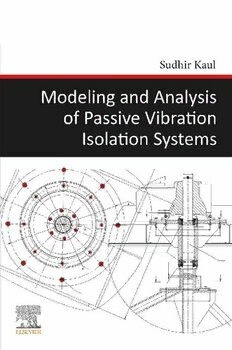
Modeling and Analysis of Passive Vibration Isolation Systems PDF
Preview Modeling and Analysis of Passive Vibration Isolation Systems
MODELING AND ANALYSIS OF PASSIVE VIBRATION ISOLATION SYSTEMS MODELING AND ANALYSIS OF PASSIVE VIBRATION ISOLATION SYSTEMS SUDHIRKAUL AssociateProfessor,SchoolofEngineeringandTechnology, WesternCarolinaUniversity,Cullowhee,NC,USA Elsevier Radarweg29,POBox211,1000AEAmsterdam,Netherlands TheBoulevard,LangfordLane,Kidlington,OxfordOX51GB,UnitedKingdom 50HampshireStreet,5thFloor,Cambridge,MA02139,UnitedStates Copyright©2021ElsevierInc.Allrightsreserved. Nopartofthispublicationmaybereproducedortransmittedinanyformorbyanymeans, electronicormechanical,includingphotocopying,recording,oranyinformationstorage andretrievalsystem,withoutpermissioninwritingfromthepublisher.Detailsonhowto seekpermission,furtherinformationaboutthePublisher’spermissionspoliciesandour arrangementswithorganizationssuchastheCopyrightClearanceCenterandthe CopyrightLicensingAgency,canbefoundatourwebsite:www.elsevier.com/permissions. Thisbookandtheindividualcontributionscontainedinitareprotectedundercopyright bythePublisher(otherthanasmaybenotedherein). Notices Knowledgeandbestpracticeinthisfieldareconstantlychanging.Asnewresearchand experiencebroadenourunderstanding,changesinresearchmethods,professionalpractices, ormedicaltreatmentmaybecomenecessary. Practitionersandresearchersmustalwaysrelyontheirownexperienceandknowledgein evaluatingandusinganyinformation,methods,compounds,orexperimentsdescribed herein.Inusingsuchinformationormethodstheyshouldbemindfuloftheirownsafety andthesafetyofothers,includingpartiesforwhomtheyhaveaprofessionalresponsibility. Tothefullestextentofthelaw,neitherthePublishernortheauthors,contributors,or editors,assumeanyliabilityforanyinjuryand/ordamagetopersonsorpropertyasamatter ofproductsliability,negligenceorotherwise,orfromanyuseoroperationofanymethods, products,instructions,orideascontainedinthematerialherein. BritishLibraryCataloguing-in-PublicationData AcataloguerecordforthisbookisavailablefromtheBritishLibrary LibraryofCongressCataloging-in-PublicationData AcatalogrecordforthisbookisavailablefromtheLibraryofCongress ISBN:978-0-12-819420-1 ForInformationonallElsevierpublicationsvisitourwebsiteat https://www.elsevier.com/books-and-journals Publisher:MatthewDeans AcquisitionsEditor:DennisMcGonagle EditorialProjectManager:HilaryCarr ProductionProjectManager:PrasannaKalyanaraman CoverDesigner:designerChristianBilbow TypesetbyAptara,NewDelhi,India Contents Preface vii Dedication ix Acknowledgment xi 1. Vibrationisolation—background 1 1.1 Introduction 1 1.2 Isolatormaterials 1 1.3 Commonelastomericisolatordesigns 4 1.4 Stiffnessanddamping 4 1.5 Single-degree-of-freedomsystem 9 1.6 Multiple-degree-of-freedomsystem 16 Reviewexercises 24 References 25 2. Viscoelasticmodeling—passivevibrationisolators 27 2.1 Viscoelasticity 27 2.2 VoigtorKelvin–Voigtmodel 28 2.3 Zenermodel 30 2.4 Maxwell–Voigtmodel 33 2.5 GeneralizedMaxwellorMaxwellLaddermodel 37 2.6 Voigtfractionalmodel 40 2.7 MVfractionalmodel 42 2.8 Hysteresismodel 44 Reviewexercises 58 References 60 3. Vibrationisolationsystemmodeling 61 3.1 Planarisolationsystems(threedegrees-of-freedom) 61 3.2 Spatialisolationsystems(sixDOFs) 67 3.3 Vibrationisolationsystemwithdisplacementlimitingdesign 70 3.4 Vibrationisolationsystemwithhysteresis 73 Reviewexercises 88 References 89 v vi Contents 4. Vibrationisolationsystems—nonlinearmodels 91 4.1 Singledegree-of-freedomisolatorwithstiffnessnonlinearity 91 4.2 Single-DOFisolatorwithstiffnessanddampingnonlinearity 99 4.3 Planarisolationsystemwithstiffnessanddampingnonlinearity 104 4.4 Othernonlinearmodels 107 Reviewexercises 116 References 117 5. Modelingelastomercharacteristics 119 5.1 Mullinseffect 119 5.2 Payneeffect 124 5.3 Aging 128 5.4 Creep 131 5.5 Hyperelasticmodel 135 Reviewexercises 140 References 141 6. Modelinginertiaeffect 143 6.1 Inertiaeffect 143 6.2 Inertiaeffect—single-degree-of-freedommodel 145 6.3 Inertiaeffect—two-degree-of-freedommodel 153 6.4 Inertiaeffect—three-degree-of-freedommodel 162 Reviewexercises 168 References 169 7. Elastomericvibrationisolatordesign 171 7.1 Example—single-degree-of-freedomisolatordesign 171 7.2 Example—planarisolationsystemdesign 178 7.3 Example—spatialisolationsystemdesign 184 7.4 Casestudies 190 References 207 AppendixA 209 AppendixB 215 Index 219 Preface Passive vibration isolators are widely used in areas such as automotive, aerospace,manufacturing,heavymachinery,andcivilstructures.Ontheone hand,the design and development of passive vibration isolators is a mature technology.Ontheotherhand,analyticalmodelingofsuchisolationsystems is still evolving due to the multifaceted intersection of different disciplines. Theaimofthisbookistoserveasareferenceforengineersandresearchers involvedinthedesign,development,modeling,analysis,andtestingofpassive vibration isolation systems. Thisbookhasbeendividedintosevenchapters.Chapter1presentsabrief review of vibration analysis and terminology.The aim of this chapter is to serve as a refresher;this chapter can be used in conjunction with Appendix AandAppendixBtorecapitulatethecontentfromanintroductorycourse invibrationanalysis.Chapter2presentsseverallinearviscoelasticrheological modelsthatcanbeusedforasingle-degree-of-freedomanalysisofvibration isolation systems.The main attributes of each model are discussed in this chapter along with the governing relationships between critical model and design parameters.Chapter 3 presents linear viscoelastic models for planar (two- and three-degree-of-freedom) and spatial (six-degree-of-freedom) vibration isolation systems.Additional models for piecewise behavior and hysteretic systems are also presented in this chapter. Chapter 4 presents nonlinear modelsforsingle-degree-of-freedom systemsaswellasmultiple- degree-of-freedom systems that can be used for the analysis of passive vibration isolation. Although nonlinearities can be attributed to multiple sources,thischapterprimarilyfocusesonanalyticalmodelsforafewspecific nonlinearitiesassociatedwithstiffnessanddampingcharacteristics.Chapter 5 presents models that are typically used for the analysis of elastomeric vibration isolators.Models that can be used to represent such phenomena as Mullins effect, Payne effect, hyperelasticity, aging, and creep have been discussed in this chapter. Chapter 6 presents models that can be used to accountfortheinertiaeffectthatistypicallyobservedinvibrationisolation systems that need to withstand very high excitation frequencies. These models allow an evaluation of vibroacoustic characteristics well above 1 kHzwhilecapturinginternalresonanceandwaveeffects.Chapter7presents examplesandcasestudiesthatintegrateconceptsfromthemodelspresented in the previous chapters of the book while demonstrating the influence of vii viii Preface the vibration isolation system on overall system dynamics. There are two brief appendices that may be used as a refresher on ordinary differential equationsandmatrixalgebra.Eachchapterhasafewexerciseproblemsthat can be solved to test the understanding of the content presented in the chapter. The models discussed in this book encompass a wide range that can be useful for the analysis of passive vibration isolation systems.While some of the models presented in this book have been used for quite some time, others are relatively new and offer useful options for gaining an analytical insight that can be used for design.Furthermore,some of the models are phenomenological, while others are semi-empirical; therefore allowing a design or analysis engineer to customize the models during the product development process. Some of the models for elastomeric materials and nonlinear behavior that have been discussed in this book are active areas of research and continue to be discussed and investigated in the existing literature. A surge in the use of electric powertrains has resulted in new requirementsforpassivevibrationisolationsystems,afewmodelspresented in this book are possible options for the analysis of internal resonance in such systems. I hope that the variety of models discussed in this book is useful in the design and development of passive vibration isolation systems by holistically accounting for vibration response, system dynamics, design parameters,and isolator design. Dedication Dedicatedtomymother,whoselifewasabeaconofperseverance,resilience, humility,and kindness. Dedicatedtomyfather,whoselifecontinuestoinspiremewithaninsatiable love for learning. ix
